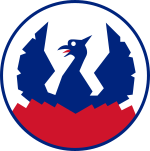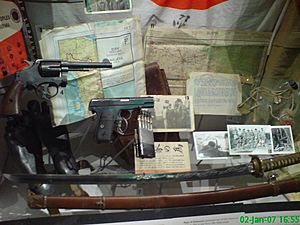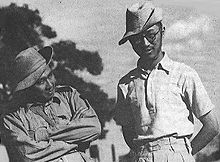Force 136 facts for kids
Quick facts for kids Force 136 |
|
|---|---|

Patch of the Allied South East Asia Command
|
|
| Founded | 1941 (as India Mission) 1942 (as GSI(k)) 1944 (as Force 136) |
| Country | |
| Allegiance | Allied forces |
| Type | Wartime intelligence organisation for Far east Special forces |
| Role |
|
| Part of | Special Operations Executive |
| Headquarters | Kandy, Ceylon (now known as Sri Lanka) |
| Mascot(s) | Phoenix |
| Engagements | World War II
|
| Disbanded | 1946 |
| Commanders | |
| Notable commanders |
Colin Mackenzie |
Force 136 was a secret British organization during World War II. It was part of the Special Operations Executive (SOE), which was a special group that helped fight the enemy in secret ways. Force 136 was first set up in 1941 as the India Mission. Later, in 1944, it became known as Force 136. Its main leader was Colin Mackenzie.
The group's job was to support and supply local resistance fighters in countries that Japan had taken over. They also carried out secret missions to damage enemy operations. Force 136 worked in places like Burma, Malaya, China, Sumatra, Thailand, and French Indochina from 1941 to 1945.
Even though British officers were in charge, most of the agents they trained were local people from these regions. For example, people from Burma, India, and China were trained to work as agents in Burma. British officers also went behind enemy lines to train resistance groups. Many former government workers or business people who knew the local languages and areas were very helpful to Force 136. Famous agents included Freddie Spencer Chapman in Malaya and Hugh Seagrim in Burma.
Contents
History of Force 136
The SOE was created in 1940 to encourage and supply resistance groups in enemy-occupied areas. At first, the main enemies were Nazi Germany and Italy. But by late 1940, it became clear that a war with Japan was also coming.
Two groups were sent to set up SOE operations in the Far East. The first group, led by Valentine Killery, set up its base in Singapore. However, Singapore was captured by Japan in February 1942, soon after Japan joined the war.
A second group was started in India by Colin Mackenzie. His "India Mission" first worked from Meerut in North West India. This location was chosen because of fears that Germany might take over the Middle East. Later, when that threat passed, the focus moved to Southeast Asia.
The India Mission was first called "GS I(k)" to make it seem like a regular record-keeping office. The name Force 136 was officially adopted in March 1944. In December 1944, the main headquarters moved to Kandy in Ceylon. Here, it worked closely with the South East Asia Command. Force 136, along with the rest of SOE, was closed down in 1946 after the war ended.
How Force 136 Was Organized
Command Structure
Force 136 was divided into three main groups to carry out secret missions across Asia.
| Group | Area of Responsibility | Headquarters Location |
|---|---|---|
| Force 136 HQ | Far East | India, then Kandy, Ceylon |
| A | Burma and French Indochina | Rangoon, Burma |
| B | Malaya and the East Indies | Kuala Kangsar, Perak |
| C | China | Hong Kong |
Typical Team Setup
A normal Force 136 team had 8 agents. This included two commanders, two agents for demolitions (blowing things up), one radio operator, one agent to decode messages, and two scouts.
Training for Agents
Force 136 agents received special forces training from the British Military. Their training lasted three months and taught them many skills. These included stalking, silent killing, demolition, jungle patrolling and survival, using radios, spying, parachuting, and silent swimming.
Some of the places where Force 136 agents trained were:
- The Eastern Warfare School (also called Jungle Training Course) in Poona, India.
- The Royal Marine Group Instructional Wing in Colombo, Ceylon. This was a stopover for commando forces before major campaigns.
- Commando Bay at Okanagan Lake, Canada.
Operations in Different Regions
Malaya Operations


Before the Japanese attacked Malaya, SOE tried to set up resistance groups. But their plans were stopped by the British governor. They could only start serious efforts in January 1942, after the Japanese Invasion of Malaya had already begun.
A special warfare school, STS 101, was set up by explorer Freddie Spencer Chapman. Chapman himself led the first missions behind Japanese lines. Although the school's trained agents carried out some attacks, they were cut off when Singapore fell.
Working with the Malayan Communist Party
Before the war, the Malayan Communist Party (MCP) was already against the Japanese. Its members were mostly Chinese. When Singapore was about to fall, the British told the MCP to hide in the forests.
The Communists formed the Malayan Peoples' Anti-Japanese Army (MPAJA). They got their first weapons from STS 101 or from abandoned British army depots. The MPAJA set up strict camps in the forest, getting food from Chinese workers and farmers. Chapman stayed in Malaya after Singapore fell, but he had no radio to contact Allied forces. Still, the MPAJA saw him as the official British contact.
In February 1945, a radio finally worked, and Chapman could report to Force 136 HQ in Kandy. By then, Force 136 had many resources. In the last few months of the war, they sent 2,000 weapons and 300 liaison people to the MPAJA. About half of these were British, and the others were Chinese who had traveled to India for training. With these supplies, the MPAJA grew into a large guerrilla army of about 7,000 fighters. However, Japan surrendered before they could start a major uprising.
Malay Resistance Groups
Force 136 also helped set up three local Malay resistance groups after reaching Malaya. British officers and agents from SOE helped each group. All the agents were from the Malay ethnic group who were working or studying overseas before the war.
- Ulu Perak: In December 1944, a group of five Malay SOE agents and two British officers parachuted into Perak. They aimed to create a guerrilla force and set up radio contact with Force 136 HQ. They formed the Askar Melayu Setia (Loyal Malay Troops). Their base in Kuala Kangsar became the main HQ for Force 136 in Malaya.
- Kedah: In July 1945, a team parachuted into Kedah to set up a guerrilla force in the northern Malay Peninsula. They worked with Tunku Abdul Rahman (who later became the first Prime Minister of Malaysia) and established a resistance group there.
- Pahang: A team parachuted into Raub, Pahang to set up radio contact for the east coast and create guerrilla forces. They worked with Yeop Mohidin and formed Force 136 Pahang, also known as Wataniah Pahang. This group was the start of the modern Rejimen Askar Wataniah (Territorial Army Regiment).
- Terengganu: A team, including Ibrahim Ismail, parachuted into Terengganu. However, they were betrayed and captured by the Japanese.
China Operations
From 1938, Britain supported the Republic of China against Japan by sending supplies through Burma. SOE had plans for China, but these ended when Japan took over Burma in 1942.
One group, Mission 204, tried to help the Chinese Nationalist Army. Another group, the British Army Aid Group, worked near Hong Kong.
In Operation Remorse, a businessman named Walter Fletcher carried out secret economic operations in Japanese-occupied China. These activities actually made a profit for SOE in the Far East.
Thailand Operations
In December 1941, Thailand allied with Japan. However, some Thais formed the Free Thai Movement to resist. Force 136 and the American OSS supported the Free Thai Movement. This group provided important information from inside Thailand. When the war turned against Japan, the Thai leader was forced to resign, and a Free Thai government was formed. A plan to disrupt Japanese forces in 1945 was stopped when the war ended.
Burma Operations
Burma (now Myanmar) was a major battleground in Southeast Asia from late 1942. Force 136 was very involved. It helped free the country by building up a national resistance organization that was very effective in 1945.
SOE had two separate sections for Burma. One focused on minority groups in border regions, and the other worked with nationalist movements among the majority Bamar people in central Burma.
Working with Minority Groups
Among the minority peoples of Burma, like the Chins, Karens, and Kachins, there were mixed feelings about the Bamar, Japanese, and British. In 1942, the pro-Japanese Burma Independence Army tried to disarm Karens, leading to a civil conflict that turned the Karens against the Japanese.
The Karens were the largest minority group. Many had served in the British forces and were left with weapons and instructions to wait for orders. This helped make their resistance effective. A British officer, Hugh Seagrim, even surrendered himself to the Japanese to protect the local people and was executed.
Force 136 continued to supply the Karens. From late 1944, they launched Operation Character, dropping three-person teams to organize large-scale resistance. In April 1945, Force 136 helped start a major uprising in the region. This helped the Allied advance on Rangoon. After Rangoon was captured, Karen fighters continued to fight Japanese units. At their peak, the Karens had about 8,000 active fighters.
Burmese Political Connections
The Burma section of Force 136 was led by John Ritchie Gardiner, who knew some Burmese politicians. In 1942, many Bamar people were sympathetic to the Japanese. But during the occupation, this changed. The Burma National Army (BNA), under Japanese control, started to turn. In 1944, Aung San, the Burmese nationalist leader, formed the Anti-Fascist Organisation (AFO) with communist and socialist leaders. Force 136 connected with this group.
During the final Allied push into Burma in 1945, there were several uprisings against the Japanese. Force 136 supported these, even though they had little control over the BNA. The entire BNA changed sides on March 27, 1945.
The AFO forces, including the BNA, were renamed the Patriotic Burmese Forces. They helped recapture Rangoon and clear out Japanese resistance. Force 136 helped Aung San and his forces become accepted as Allied fighters.
Indian National Army
Another group fighting under Japanese command in Burma was the Indian National Army (INA). This force was made up of former prisoners of war captured by the Japanese. However, Force 136 was not allowed to work with anyone in the INA.
Field Operations
Force 136 also carried out more traditional military operations behind Japanese lines in Burma. These missions involved groups of up to 40 soldiers with officers and a radio operator. They would go behind enemy lines to gather information and destroy enemy supplies. These missions could last several weeks and were supplied by planes.
The radio operator was very important. They would climb to high points to send and receive messages. To avoid capture, every SOE agent carried a cyanide pill. One such radio operator, James Gow, wrote about his experiences. He was sent with Gurkhas to find Japanese forces after the Battle of Kohima.
Korean Liberation Army
In June 1943, the Korean Liberation Army and Britain made an agreement. The Korean Independence Army would send a team to work with the British army against Japan. This team, called KNALU, would help with things like translating enemy documents and creating propaganda. The British military would cover all their expenses and treat them like British officers. This agreement officially allowed the Korean Liberation Army to send a team to the British Army Headquarters in India.
Other Operations
French Indochina Section
Force 136 played a small part in trying to organize local resistance in French Indochina. From 1944 to 1945, planes from Force 136 dropped French commandos and agents into North Indochina. However, the French could not stop the Japanese coup in March 1945, and some were captured or forced to retreat.
Dutch East Indies and Australia
Except for the island of Sumatra, the Dutch East Indies were not under the command of Force 136 until after Japan surrendered. In 1943, there were plans for an invasion of Sumatra, and SOE did some scouting there. However, the plan was canceled.
After the Japanese surrender in September 1945, about 20 small teams were parachuted into the Dutch East Indies. These teams, called RAPWI (Repatriation of Allied Prisoners of War and Internees) Teams, were tasked with finding and caring for prisoners of war and others held in camps. They used Japanese surrendered troops to arrange food, shelter, and medical supplies, saving many lives.
Another Allied intelligence group, Special Operations Australia (SOA), also known as Force 137, operated from Australia against Japanese targets in Singapore and other islands. This group included Z Special Unit, which successfully attacked ships in Singapore Harbour.
How Agents Traveled
Until mid-1944, Force 136's operations were difficult because of the long distances. For example, flying from Ceylon to Malaya and back was a 2,800-mile trip. This also made it hard to use small boats to deliver supplies or people by sea. The British and Dutch navies provided few submarines. Eventually, converted B-24 Liberator aircraft were used to parachute agents and supplies.
In Burma, where distances were shorter, Dakota transport planes or Westland Lysander planes could also be used.
Notable Agents of Force 136
These secret agents received training directly from SOE in India, Ceylon (now Sri Lanka), or Canada.
- Bob Maloubier – A Frenchman who worked for SOE. He parachuted into Japanese-occupied Laos and was captured. He later helped start the French secret service. He also designed the world's first modern diving watches.
- David Smiley – A British special forces officer. He joined SOE and carried out missions in the Middle East. He was then sent to Force 136 to rescue prisoners of war (POW) behind enemy lines. He parachuted into Thailand and rescued French agents and other POWs from French Indochina. He was honored for his rescue operations.
- Chin Phui Kong – A student from Borneo who was recruited by SOE for Force 136 because he spoke English, Malay, and Chinese. He trained in commando skills, parachuting, and demolition in India. He parachuted into Malaya to train local guerrillas. After the war, he became a famous marine biologist.
- Douglas Jung – A Canadian Army officer. He was one of 150 Asian-Canadians recruited into Force 136. He trained in commando skills and parachuting. After the war, he became the first Member of Parliament in Canada from a minority ethnic group.
- Freddie Spencer Chapman – A British Army officer who stayed behind enemy lines after Japan took over Malaya. He remained in Malaya for two years before contacting Force 136 agents. He continued to sabotage Japanese forces before escaping by submarine in 1945. He later became a writer.
- Ibrahim Ismail – A military cadet who joined Force 136. He parachuted into Terengganu but was betrayed and captured by the Japanese. He pretended to be a double agent for the Japanese but secretly gave them false information. For his cleverness, he was honored by the British. He later became the 5th Chief of Defence Forces (Malaysia).
- Jean Le Morillon – A French Navy sailor who joined Force 136. He trained in commando skills and parachuting in India. He parachuted into French Indochina and was captured by the Japanese secret police. He was rescued by David Smiley and continued to rescue prisoners of war. His life as an agent and prisoner is well-known in France.
- Jean Sassi – A French Army intelligence officer and paratrooper. He joined Force 136 and parachuted into Laos. He later became a commander of a special forces regiment.
- John Davis – A Malayan Police intelligence officer. He commanded Operation Gustavus, which involved being sent into Malaya by submarine. He later became the head of Malayan Force 136 agents. He became a writer after leaving the military.
- Lim Bo Seng – A famous war hero from Singapore. He escaped Singapore during the Japanese invasion and joined SOE in India. He was part of Operation Gustavus and was captured by the Japanese secret police, dying in prison in 1944.
- Tan Chong Tee – A Singaporean badminton player who became an agent. He escaped Singapore and joined SOE in India. He was part of Operation Gustavus, was captured, and released after the war. He continued to play badminton for Singapore.
- Tunku Osman – A Malayan student who joined the British Army. He transferred to Force 136 and trained in commando skills and parachuting in India. He parachuted into Malaya. He continued to serve with the Malaysian Army and later became the 3rd Chief of Defence Forces (Malaysia).
- Walter Fletcher – A British businessman who became an agent. He was part of Operation Remorse, sent to China to smuggle goods out of Japanese-occupied areas. He later became a Member of Parliament.
- William Frank Harding Ansell – A British Army officer who fought in Burma. He joined Force 136. He became interested in zoology while fighting and later became a famous zoologist, with several animal species named after him.
Legacy of Force 136
Force 136 Camp, Pekan, Pahang
On October 27, 2011, the Sultan of Pahang, Sultan Ahmad Shah, named a new Malaysian Army military camp in Pekan, Pahang, Malaysia, as Kem Force 136 ('Force 136 Camp'). This camp is now the headquarters for a battalion of the Malaysian Territorial Army Regiment.
Commando Bay, Okanagan Lake, Canada
A bay on Okanagan Lake in British Columbia, Canada, was where the first group of Asian-Canadian Force 136 members received commando training. In 2014, the Canadian government renamed the bay Commando Bay and made it a historical site. There is a war memorial there.
|

